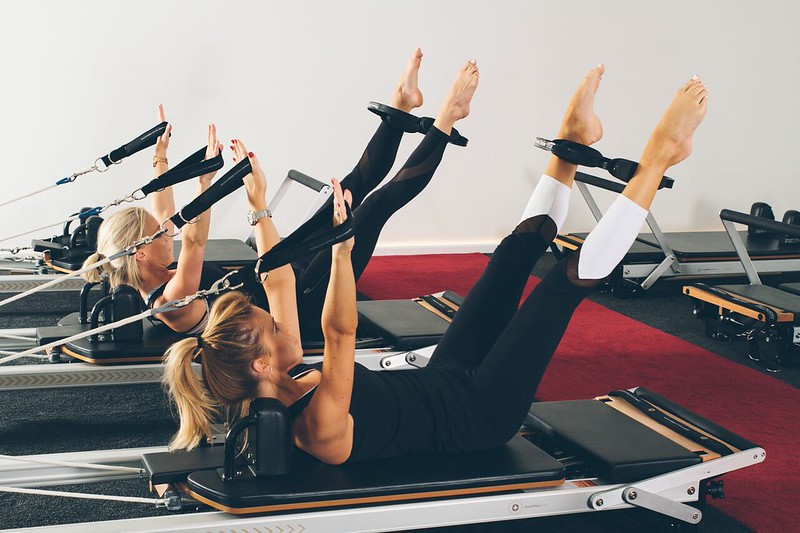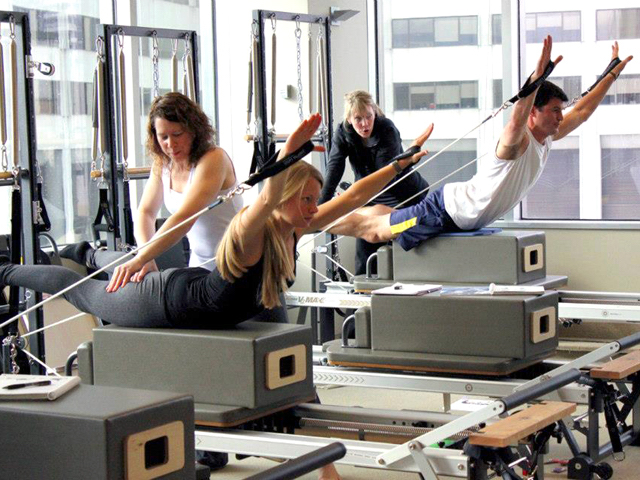What’s the best way to get in shape for a total beginner?
Is it running? Yoga? Rowing?
Or is it pilates?
Pilates is a type of strength training that’s low-impact and easy on the joints. It uses a variety of mat exercises to strengthen your muscles and increase your flexibility.
Some pilates routines also incorporate exercise machines and equipment like medicine balls to up the intensity, but you don’t need them to get started. All you really need is a gym mat, which makes pilates an ideal exercise to do at home.
But if you’ve never tried pilates before, you may be wondering if it’s right for you.
So what are the pros and cons of pilates? What are the benefits and disadvantages of pilates?

Overall, pilates is easy to get started with at home or a studio. Regular practice will give you benefits like a rock solid core and drastically improving your flexibility and mobility. You’ll look and feel a lot better in no time!
However, one disadvantage of pilates is that advanced movements can put beginners at an increased risk for injury. And despite the challenging workouts, there are way better methods to burn calories for weight loss. However, pilates pairs extremely well with other forms of exercise for a well-rounded routine.
To help you decide if this exercise regimen can help you achieve your fitness goals, let’s dive deep into a list of the major pros and cons of pilates.
Pros of Pilates (Benefits)
Pilates is mainly known for providing a great core workout, but it has a lot of other benefits too.
Here are some of the main advantages of adding pilates to your fitness routine.
No equipment necessary
Pilates requires minimal equipment, so it’s a great exercise regimen to try at home.
All you really need to get started is a gym mat and an instructional video that shows you how to do some basic moves.
Here are some examples of challenging pilates exercises you can do without any special equipment:
- Rolling Like a Ball—an exercise where you pull your legs into your chest and rock back onto the mat, which massages your back and strengthens your core
- The Hundred—classic pilates move where you pump your arms up and down while lifting your legs and head off the mat, which is great for your core
- Single Leg Teaser—like a crunch performed with one leg raised, or two for extra difficulty
As you advance in your pilates practice, though, you may want to consider investing in some equipment.
Exercise machines like the reformer and smaller props like medicine balls can increase the intensity and variety of your workouts, so they’re worth having on hand.
Low-impact
If you’re looking for a low-impact workout that won’t strain your muscles and joints, pilates fits the bill.
Pilates exercises focus on gently stretching and strengthening your muscles through slow, controlled movements. Unlike burpees and other high-intensity exercises, they aren’t hard on your knees.
Most pilates moves are also performed lying or sitting down on a padded mat, which helps take stress off of your joints.
Research has shown that doing pilates can ease pain from arthritis and fibromyalgia. Pilates may also help manage back pain because it strengthens the abdominal and pelvic floor muscles that provide support to your spine.
So even if you have back pain and joint problems, pilates may still be suitable for you—just make sure you check with your doctor before you try it.
Strengthens your muscles (especially your core)
Although pilates is a relatively low-impact workout, you’ll still feel the burn after you get up from your mat, especially in your abs.
Most classic pilates moves target your abdominal muscles, and they seem to do a better job of it than regular crunches.
One study showed that women who did pilates in the months after giving birth experienced a greater increase in core strength than women who did conventional ab exercises.
Pilates doesn’t just strengthen your abs, though. It also works the muscles in your hips, pelvis, butt, and back.
There are lots of moves that target your arms and upper body too, including arm circles and pilates push-ups.
As long as you perform a variety of exercises that target different muscle groups, pilates can be a great full-body workout.
Improves your flexibility, posture, and balance
Pilates doesn’t just strengthen your muscles—it also stretches them, which helps promote flexibility.
A recent study showed that practicing pilates for just eight weeks can increase your flexibility. The study also found that pilates improves static balance, which is your ability to hold yourself in place in certain positions.
This makes sense given the fact that many moves require you to raise your arms or legs and hold them still, which requires a lot of coordination.
Pilates not only improves your coordination and flexibility, but also gives you better posture by improving your core strength.
Many exercises strengthen the supporting muscles in your abdomen and back that are necessary for maintaining good posture.
Cons of Pilates (Disadvantages)

Doing pilates is a great way to strengthen your core and improve your flexibility.
But this popular exercise regimen does have a few major drawback and disadvantages.
You’ll still need to do cardio
Pilates is a fairly intense, full-body workout, but it’s mostly focused on strengthening your muscles.
It won’t elevate your heart rate as much as running on the treadmill or condition your body the same way that a good cardio session does.
So if you want to increase your endurance and get in shape, it’s best to incorporate both pilates and a form of cardio into your fitness routine.
It’s not the best way to burn calories
Pilates doesn’t burn as many calories as other forms of exercise like cycling and jogging, so it may not be the most efficient way to shed pounds.
According to WebMD’s fitness calculator, someone who weighs 150 pounds can expect to burn 218 calories during an hour long pilates class.
Running for the same amount of time will burn 544 calories, which is more than double.
So if you’re trying to lose weight and can only squeeze in a few workouts a week, you may be better off choosing running and other aerobic exercises over pilates.
Ideally, you’d pair pilates or another strength-training activity with some form of cardio, even just long walks, to ratchet up your weekly calorie-burn.
Risk of injury, especially for beginners
Even though pilates is low-impact, there’s still a risk of injury if you don’t maintain proper form.
Pilates exercises may look simple, but they require a lot of control, precision, and core strength.
If you perform movements incorrectly or try to power through exercises that you don’t have the abdominal strength for yet, you may end up straining the muscles in your neck and back.
That’s why it’s often recommended that you work with an experienced pilates teacher, especially if you’re just starting out. They’ll be able to suggest exercises that suit your skill level and give you tips to improve your form.
You can also sustain injuries from using pilates equipment like the reformer.
It’s an exercise machine that has a lot of moving parts—spring-loaded levers, straps, bars, and a moving platform with wheels that you lie down on.
If you’re not careful when using the reformer, you could fall off of it. So make sure you stay focused and follow your trainer’s instructions to avoid getting hurt.
(This is another small disadvantage of pilates — if you want to use a reformer, you’ll need to take classes in a studio, which can get quite expensive.)
You probably won’t get ripped
Pilates is great for strengthening your core and giving you a more toned, athletic look.
But will you get ripped like a bodybuilder from your pilates practice? Probably not.
To get big, bulging muscles, you have to progressively increase the resistance of your workouts to challenge your body. Pilates exercises mainly use your body weight to create resistance, so there’s a limit to the load you can put on your muscles.
(Check out whether lifting weights is right for you.)
Although there are ways to add more resistance to your workouts, such as using pilates equipment like the reformer, there’s only so much you can accomplish without weights.
That’s why fitness experts recommend combining pilates with weight training if you want to get in shape and achieve the best body composition.
Wrapping Up
So what are the pros and cons of getting started with pilates?
Pilates is a full-body workout that you can do from home with just an exercise mat. That makes it really appealing for beginners.
The exercises are gentle and easy on the joints, but still provide enough resistance to strengthen and tone your muscles over time. It’s excellent for your overall health (strength, core stability, flexibility, etc.) in the long run.
You’ll still have to do cardio to condition your body, and you may not lose weight or get ripped from your pilates practice without the right diet or additional exercise.
But if you just want to get a little stronger and improve your flexibility, doing pilates is a great way to achieve those goals.
Are you a pilates nut? What did I miss, and what are your favorite things about pilates?
Before you go, check out tips from actual instructors on how to prepare for your first pilates class.
Hope this helps!